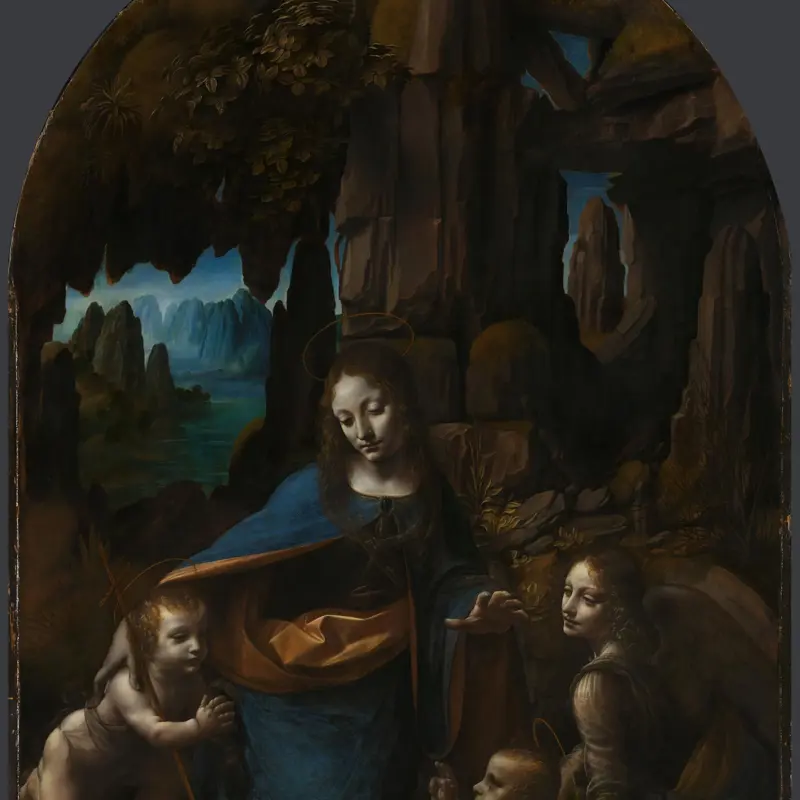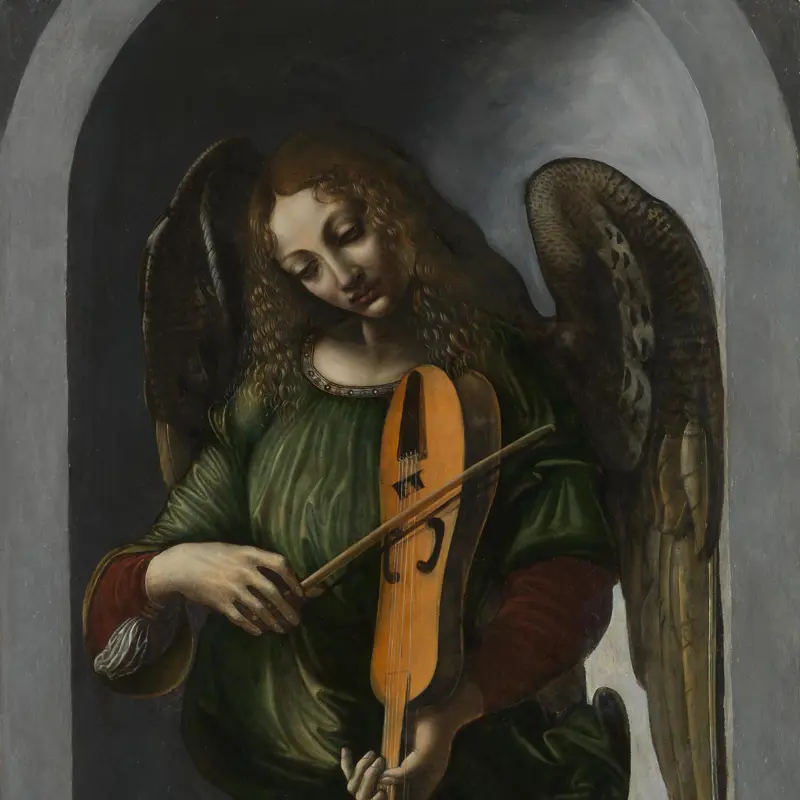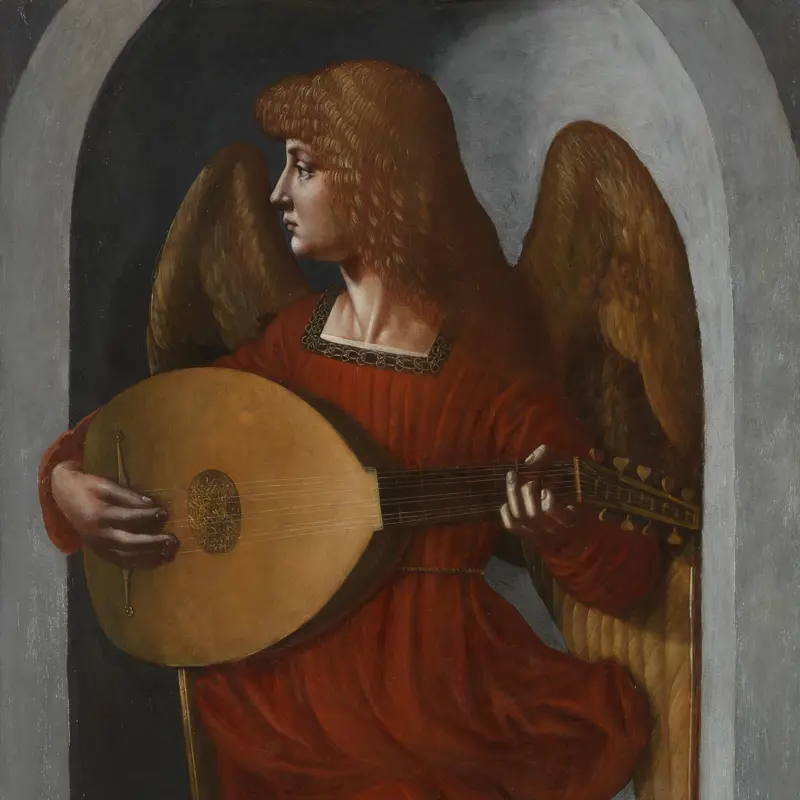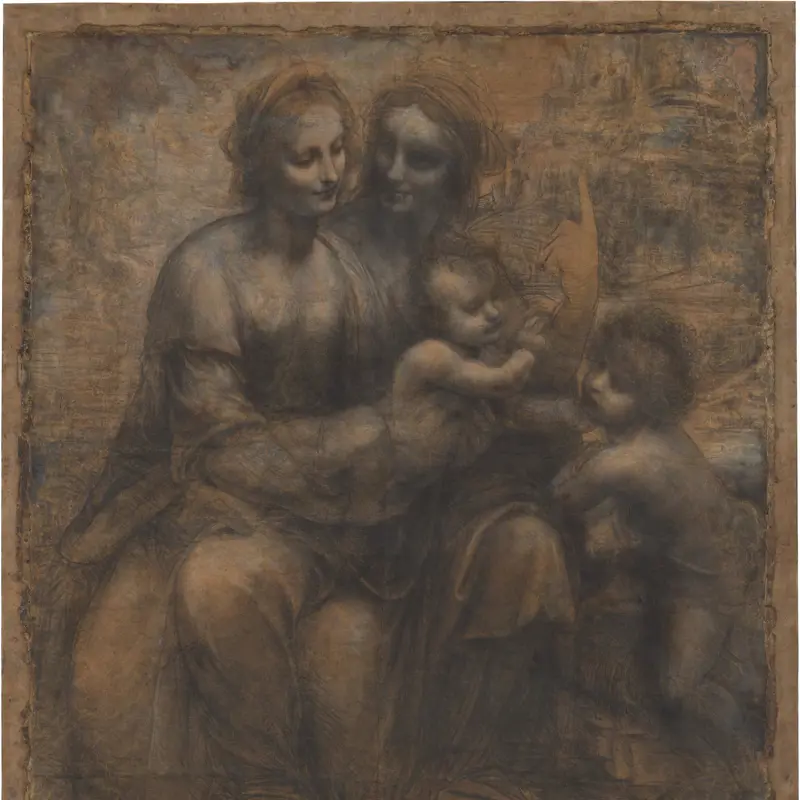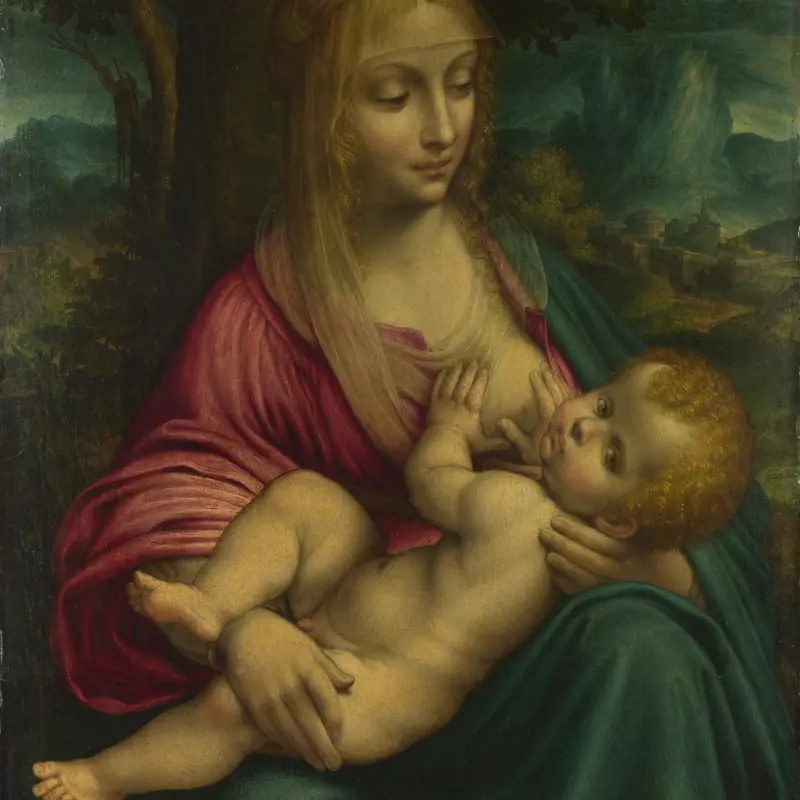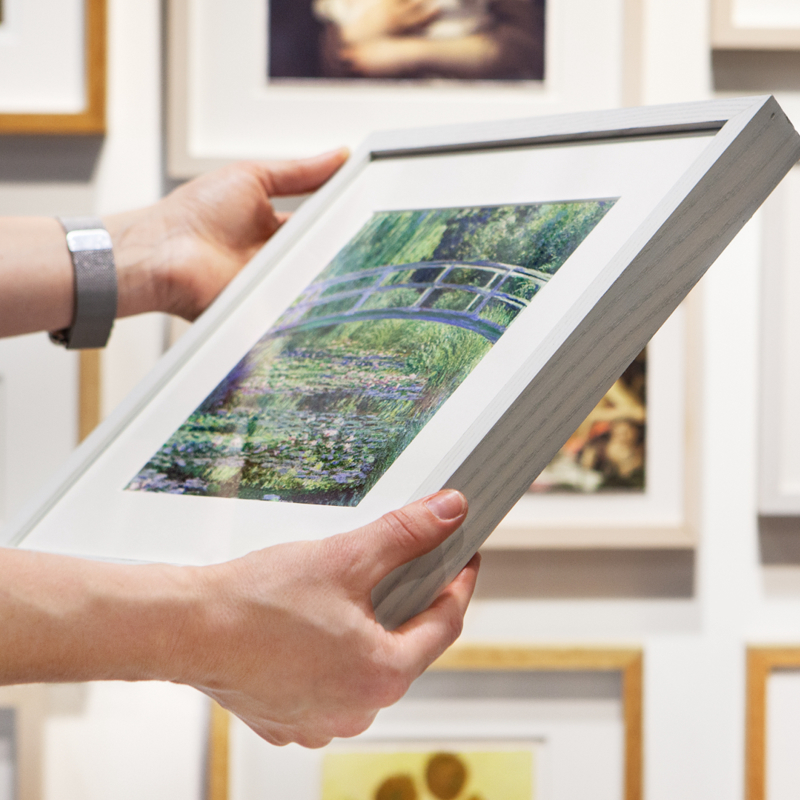associate of Leonardo da Vinci, possibly Francesco Napoletano, 'An Angel in Green with a Vielle', about 1490-9
About the work
Overview
This angel was part of an elaborate painted and sculpted altarpiece made for the church for San Francesco Grande in Milan. The main image of the altarpiece was Leonardo da Vinci’s ‘The Virgin of the Rocks’, also in the National Gallery’s collection.
This angel – playing a vielle, a type of fiddle – and its pair would have surrounded a sculpture of the Virgin Mary which stood above Leonardo’s image. We cannot be sure who painted it; it might be an artist called Francesco Napoletano, an admirer of Leonardo’s painting style who stepped in after the death of the artist from whom it was commissioned.
Here he imitates Leonardo’s dramatic use of light and shadow and blurred contours, particularly in the angel’s face, creating the effect of soft, delicate features. The angel is absorbed in music, and the overall mood is subdued, like that of Leonardo’s painting.
Key facts
Details
- Full title
- An Angel in Green with a Vielle
- Artist
- associate of Leonardo da Vinci, possibly Francesco Napoletano
- Artist dates
- 1452 - 1519; died 1501
- Part of the series
- Panels from the S. Francesco Altarpiece, Milan
- Date made
- about 1490-9
- Medium and support
- oil on wood
- Dimensions
- 117.2 × 60.8 cm
- Acquisition credit
- Bought, 1898
- Inventory number
- NG1661
- Location
- Not on display
- Collection
- Main Collection
Provenance
Additional information
Text extracted from the ‘Provenance’ section of the catalogue entry in Martin Davies, ‘National Gallery Catalogues: The Earlier Italian Schools’, London 1986; for further information, see the full catalogue entry.
Exhibition history
-
2011Leonardo da Vinci: Painter at the Court of MilanThe National Gallery (London)9 November 2011 - 5 February 2012
Bibliography
-
1671A. Santagostino, Catalogo delle pitture insigni che stanno esposte al pubblico nella città di Milano, Milan 1671
-
1674C. Torre, Il ritratto di Milano, Milan 1674
-
1787C. Bianconi, Guida di Milano, Milan 1787
-
1859G. Calvi, Notizie sulla vita e sulle opere dei principali architetti, scultori e pittori che fiorirono in Milano durante il governo dei Visconti e degli Sforza, Milan 1859
-
1882L. Malvezzi, Le glorie dell'arte Lombarda, Milan 1882
-
1893E. Motta, 'Ambrogio Preda e Leonardo da Vinci', Archivio storico lombardo, X, 1893, pp. 972-7
-
1899E.J. Poynter (ed.), The National Gallery, London, London 1899
-
1901G. Carotti, Capi d'arte appartanenti a S.E. la duchessa Joséphine Melzi d'Eril-Barbò, Bergamo 1901
-
1901National Gallery, Descriptive and Historical Catalogue of the Pictures in the National Gallery, London 1901
-
1914G. Fologari, 'Artisti lombardi del primo Cinquecento che operarono nella Venezia: Francesco da Milano', Rassegna d'arte, 1914, pp. 26-33
-
1919Polifilo, Leonardo e i disfattisti suoi, Milan 1919
-
1919W. Suida, 'Leonardo da Vinci und seine Schule in Mailand', Monatschefte für Kunstwissenschaft, XII/10-11, 1919, pp. 257-78
-
1920W. Suida, 'Leonardo da Vinci und seine schule in Mailand', Monatschefte für Kunstwissenschaft, XIII/2, 1920, pp. 279-97
-
1923C.J. Holmes, Old Masters and Modern Art: The National Gallery, Italian Schools, London 1923
-
1929C. Ricci, North Italian Painting of the Cinquecento, New York 1929
-
1939K. Clark, Leonardo da Vinci: An Account of His Development as an Artist, Cambridge 1939
-
1939W. Suida et al., Leonardo da Vinci (exh. cat. Palazzo dell'Arte, 9 May - 20 October 1939), Novara 1939
-
1940F.J.G. Rawlins, From the National Gallery Laboratory, London 1940
-
1947M. Davies, Leonardo da Vinci: 'The Virgin of the Rocks' in the National Gallery: With an Account of the Documentary Evidence Concerning the Picture, London 1947
-
1951Davies, Martin, National Gallery Catalogues: The Earlier Italian Schools, London 1951
-
1952K.D. Keele, Leonardo da Vinci Quincentenary Exhibition (exh. cat. Royal Academy of Arts, 1952), London 1952
-
1955P. Hendy, Art Treasures of the National Gallery, London, New York 1955
-
1959M.L. D'Ancona, 'Letter: The Iconography of the Immaculate Conception', The Burlington Magazine, CI, 1959, pp. 149-50
-
1968B. Berenson, Italian Pictures of the Renaissance: A List of the Principal Artists and Their Works, with an Index of Places: Central Italian and North Italian Schools, revised edn, 3 vols, London 1968
-
1973G. Melzi d'Eril, La Galleria Melzi e il collezionismo milanese del tardo Settecento, Milan 1973
-
1977H. Glasser, Artists' Contracts of the Early Renaissance, New York 1977
-
1977J. Mills and R. White, 'Analyses of Paint Media', National Gallery Technical Bulletin, I, 1977, pp. 57-9
-
1984W.S. Cannell, 'Leonardo da Vinci, "The Virgin of the Rocks": A Reconsideration of the Documents and a New Interpretation', Gazette des beaux-arts, CIV, 1984, pp. 99-108
-
1984D.A. Brown, 'A Leonardesque Madonna in Cleveland', in M. Natale (ed.), Scritti di storia dell' arte in onore di Federico Zeri, Milan 1984, pp. 291-302
-
1986Davies, Martin, National Gallery Catalogues: The Earlier Italian Schools, revised edn, London 1986
-
1991J. Dunkerton et al., Giotto to Dürer: Early Renaissance Painting in the National Gallery, New Haven 1991
-
1992P. Parlavecchia, Leonardo e Venezia (exh. cat. Palazzo Grassi, 4 April - 13 July 1992), Venice 1992
-
1993V. Terraroli (ed.), La pittura in Lombardia: Il Quattrocento, Milan 1993
-
1994C. Gould, 'The Early History of Leonardo's Vierge Aux Rochers in the Louvre', Gazette des beaux-arts, CXXIV/1511, 1994, pp. 215-22
-
1998G.B. Bora et al., I Leonardeschi: L'eredità di Leonardo in Lombardia, Milan 1998
-
1998M. Gregori, Pittura a Milano: Rinascimento e manierismo, Milan 1998
-
1998National Gallery, Heaven in Art, London 1998
-
1999P.C. Marani, Leonardo: Una carriera di pittore, Milan 1999
-
2001
C. Baker and T. Henry, The National Gallery: Complete Illustrated Catalogue, London 2001
About this record
If you know more about this work or have spotted an error, please contact us. Please note that exhibition histories are listed from 2009 onwards. Bibliographies may not be complete; more comprehensive information is available in the National Gallery Library.
Images
About the series: Panels from the S. Francesco Altarpiece, Milan
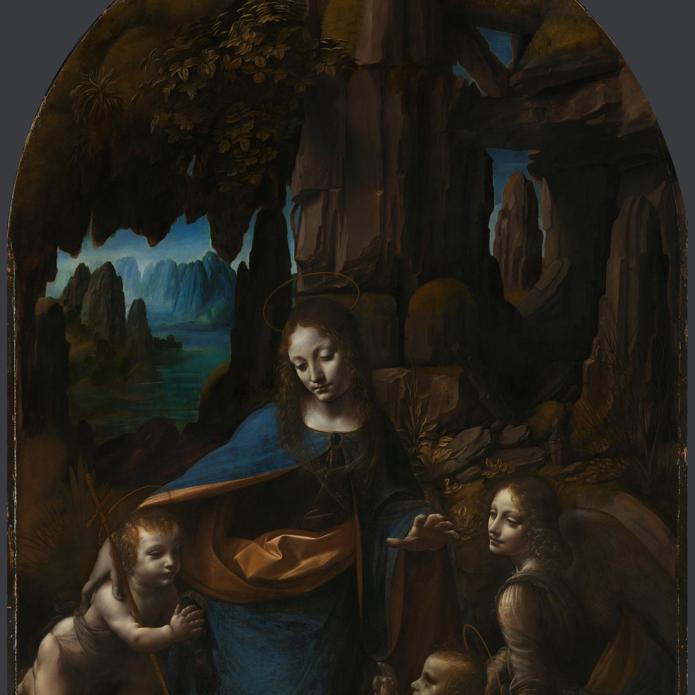
Overview
These three panels all came from an elaborate, and partly sculpted, altarpiece that was made for the church of San Francesco Grande, Milan. By the time that Leonardo and his associates were commissioned to provide paintings in 1483, the sculptor Giacomo del Maiano had already finished the sculptures.
The altarpiece stood in a chapel devoted to the Immaculate Conception of the Virgin Mary that belonged to a confraternity (religious group) devoted to the Immaculate Conception. The two angels playing musical instruments probably stood on either side of a large sculpture of the Virgin. Leonardo’s painting, which was probably supposed to represent the Immaculate Conception, was placed directly beneath the sculpture.
The National Gallery’s painting is Leonardo’s second version of the picture. It was probably made to replace one (now in the Louvre, Paris) that Leonardo sold because the confraternity refused to pay him adequately for it.

